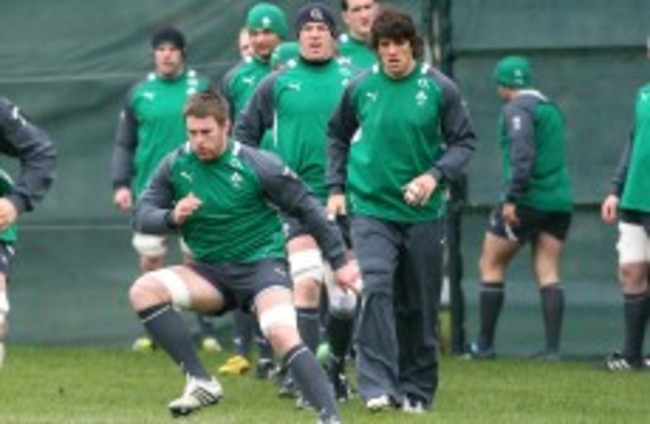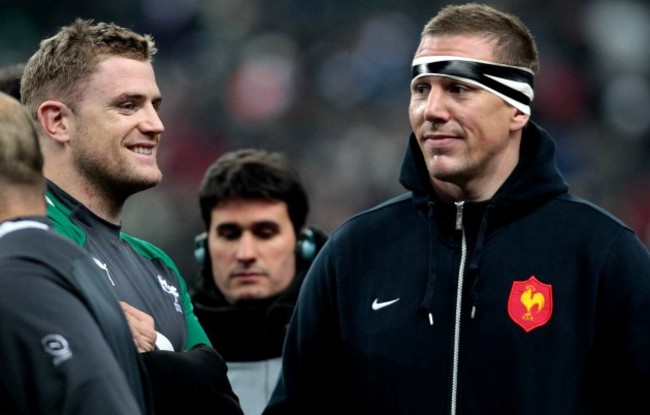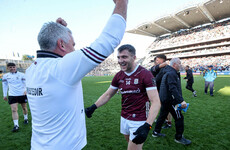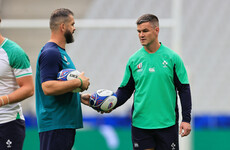Reproduced with permission from Whiff of Cordite
ONE OF OUR readers sent us a question on Facebook last week – wow, we really feel we’ve arrived now that we can write that! It was none other than Ronan Lyons, and he asked us:
I’ve stumbled on to an opinion and would like to pass it by some people who actually understand and watch rugby. Have there been two Sean O’Briens over the last 18 months? The one that played up to and including the match against Australia in RWC, who steam-rolled all before him, and the one who has played from the Wales game on, a good player but not one to set the world alight.
We, and others, chipped in with a few possible reasons: that Seanie is maybe a bit knackered, and that, to an extent, teams have found ways of curbing his impact, in particular by tackling him low around the ankles.
The most pertinent reason, though, was that O’Brien has had to defer some of his carrying duties to get involved in the dirty work in and around the ruck area. Ireland essentially have three carriers in the backrow, and one of them has to sacrifice their natural game. In New Zealand, it was Jamie Heaslip who did this, but against Wales two weeks ago, he had a hugely effective game carrying the ball, while O’Brien appeared to be playing the role of ‘fetcher’.
The answer being inextricably linked to the make-up of Ireland’s backrow gives us an opportunity to look at two myths that keep coming up around the make-up of the Irish team.
Myth 1. Ireland need a ‘genuine openside’. Without one, our backrow will always struggle.
Myth 2. Ireland’s backs are too small. We should we be putting larger fellows into midfield to compete with the likes of Wales.
Both these myths are reactionary, after recent Irish defeats – both to Wales, as it happens. In the World Cup quarter-final Sam Warburton wreaked havoc at the breakdown, continually slowed down the Irish ball, which stopped their attack at source. Quick ball is the lifeblood of any team, and as we tend to drone on, you could have world class backs from 9 to 15, but if you don’t got quick ball, you won’t see them do much.
Fast forward to now and Wales’ giant three-quarter line have smashed apart Ireland and Scotland. France also have a pretty large back line. Ireland have had 10 years of success with quick-footed, diminutive centres (Drico, Dorce and, errrr, Paddy Wallace), and the next in line have similar stature (Earls, McFadden, O’Malley). Is it time for Ireland to look at a new approach and draft in bigger men to play centre?
Waiter! Fetch me some world class 7s on a plate!
The claim that Ireland would be improved by a terrific 7 isn’t without merit. Ireland’s backrow isn’t balanced, for sure. It’s all carriers and no groundhog. Of course we’d love a world class fetcher in there. But amid the clamour from various media pundits (George Hook is like a broken record ) a few key imperatives need to be borne in mind.
You can only play what you have available. The best natural 7 in the country is Shane Jennings, at Leinster. He is a fine provincial player, but even his most ardent fans (we would count ourselves among them) would struggle to make a case for him as a first-rate international player. He is in the Leinster Heineken Cup team about 50% of the time these days. Dominic Ryan looks to have some of the key components of a 7, but he’s what we would call a ‘six and a half’, a guy who has some attributes of a 6, and some of a 7.
Peter O’Mahony has filled the 7 jersey for Munster, but he’s definitely more of a 6 – he’s too tall to be a dedicated groundhog, though he is a fine breakdown operator. We can’t simply manufacture world-class opensides overnight.
Contrary to popular belief, not every successful team has a genuine 7. New Zealand have McCaw, Wales have Warburton, and so on, but World Cup finalists and Six Nations favourites France don’t. Indeed, the French seem to have a totally different view of how the backrow should look, and it’s worked out well enough for them.
They typically set up with a ball-carrier at number 8 (Picamoles, Harinordoquy), and on either flank (it normally doesn’t matter which) station a lineout forward (Bonnaire, Harinordoquy, Jean Bouilhou at Toulouse) and a wrecking ball (Dusatoir, Gorgodze at Montpellier). Sometimes the guy playing on the openside is the guy you’d think would be on the blindside. Sometimes they switch positions. It can get a bit confusing but one thing’s for sure, there ain’t no dedicated fetcher in the French team.
France’s Imanol Harinordoquy, right, speaks with Ireland’s Jamie Heaslip after the Six Nations rugby union match against France was postponed at the Stade de France stadium. (AP Photo/Bob Edme)
The solution? It’s the gameplan, stupid. Each of Ireland’s starting backrowers are great players in their own right, and none of the alternatives at 7 look good enough to unseat the incumbents. The question is, how can Ireland get the best out of them? We’d suggest they try to reduce the number of one-out-from-the-ruck rumbles in to contact, and to offload the ball a lot more than they’re currently doing. This keeps the ball off the floor, and reduces the number of times Ireland have to fight off the likes of Sam Warburton at rucks.
On top of that, it’s a great counter to the low ‘chop tackles’ that defenders are employing to take down the likes of O’Brien and Ferris. The chop tackles leave the carrier with his arms free to get the offload away. That’s the cost of tackling low – and if you don’t make the defender pay it, you’re giving him a free lunch.
Leinster have had huge success with their offloading game, where Sean Cronin and Richard Strauss are experts at timing trailer runs onto offloads from Jamie Heaslip, Nathan Hines (last year) and latterly, Rob Kearney. Ulster have developed their game in this direction too – witness Wannenbosh’s sumptuous offload leading to Craig Gilroy’s try against Leicester.
If Ireland are to adopt this approach they’ll need more tight forwards who can handle the ball – Dan Tuohy would be a real option here, and Sean Cronin would need to be sprung from the bench more readily. Of course, you can’t offload every time, and it goes without saying that Ireland need to be phenomenally aggressive when it comes to clearing out rucks – this is something all the provinces excel at; the personnel are there to do it.
Where the deuce is the beef?!
With BOD injured and Dorce pushing on, Ireland’s midfield is in need of renovating anyway – and after the Wales game there have been no shortage of calls to beef it up with size. Bowe to 13 is one much-touted option (Frankie and Brent are in favour), while Oooooooooooohh James Downey is a possibility as a crash-ball 12. A few wrong-headed shouts for O’Brien or Ferris to convert to centre have even been seen on internet fora. It seems the nation is suddenly obsessed with the size of the Irish backs - there’s even a thread on boards.ie called ‘Can Ireland play good attacking rugby in the future without huge centres?’
Size Isn’t Everything. That’s what she said. But again, Ireland have to cut their cloth to what’s available. The only big options at centre are Tommy Bowe and James Downey. There are no Jamie Roberts’ or Aurelien Rougeries just lying around gathering dust. Bowe has very little experience at 13 – which is considered the hardest to defend on the pitch – and has enough to worry about at the moment with his patchy form. As for Downey, well if he was good enough for international rugby it’s highly unlikely he’d be sitting on the Northampton bench behind Tom May. Just because players are big doesn’t make them good. Roberts, Davies and Rougerie are great centres not because they’re big, but because they’re good footballers. Simon Danielli has similar physical stats to George North – but nothing in the way of his skill levels.
Good back play is still about football skills and lines of running – look where England have got over the last decade with any number of beefcake boshers in the backline. Lesley Vainikolo anyone? Matt Banahan? Altogether now: Ooooooooooooooooooohhhh!
Erm, it’s the gameplan again, stupid.
People need to forget about what we haven’t got, and look a bit more at what we have. As we noted a few weeks ago, a midfield of McFadden and Earls would have plenty of running threat, and plenty of pace. We need to build a plan of attack, and build it around the players’ strengths, not retreating behind fears about the size of players. As the always incisive Emmet Byrne said on Off the Ball last week, we need to look at how we can hurt teams with what we have, instead of just hoping our defence will squeeze enough mistakes out of the opposition.
It’s much the same with all our problems: the unbalanced backrow, the uncertainty at half-back, the size of our centres, the unchanging selections: they’d all be a lot less problematic if we played with a clearly identifiable, cohesive and well executed gameplan that everyone on the team bought into.













Wouldn’t be happy with medical conditions being disclosed. Could scupper a move for him